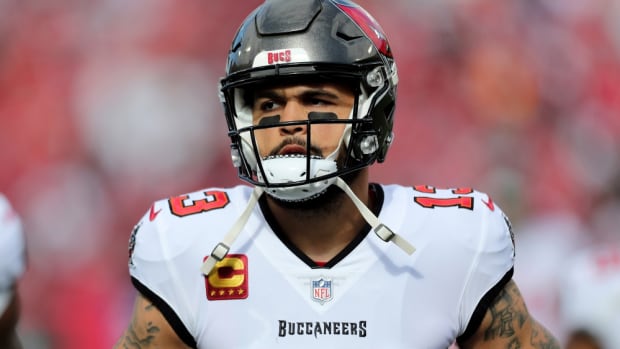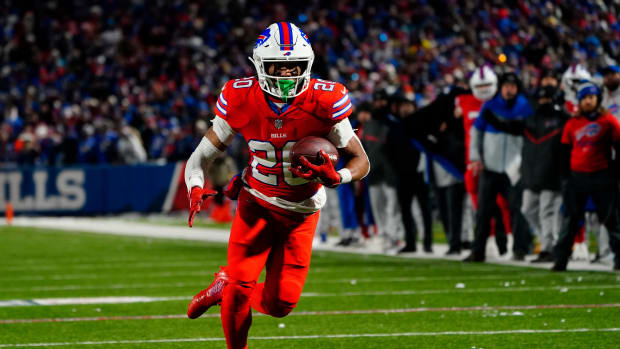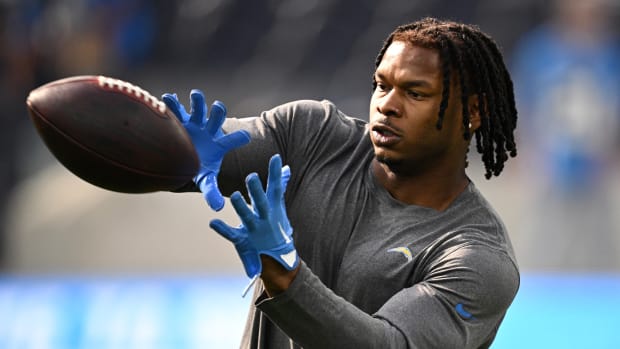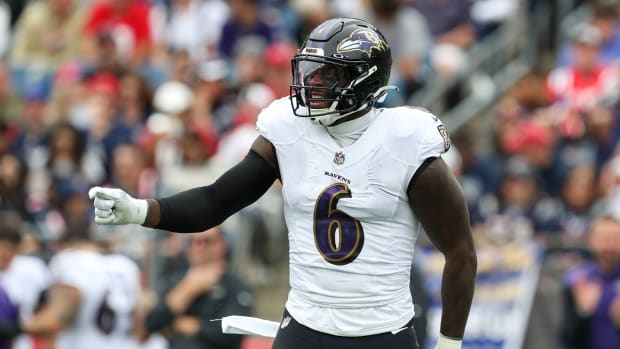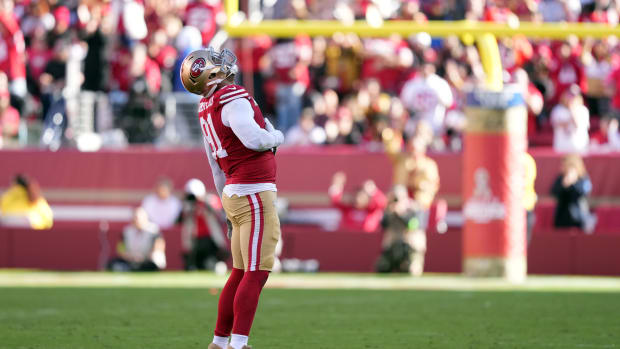
Week 9: Decisive Moments
Thomas B. Shea/Getty Images (Colts) :: Jeff Roberson/AP (Titans) :: Alex Brandon/AP (Chargers) :: Nam Y. Huh/AP (Vikings)
Week 9 in the NFL was full of drama off the field, as Peter King illustrated in his Monday Morning Quarterback column. On the field, a slate of games that looked underwhelming at the start of the day turned out to have many surprises as well.
From the Eagles and Patriots finally exploding on offense, to a record-setting comeback in Seattle, to some tough, hard-nosed games in Dallas, New York, St. Louis, Washington and Cleveland, the NFL had a little bit of everything.
We’ll touch on the plays that we think factored into wins and losses: Christian Ponder not seeing the open man against the Cowboys; Philip Rivers throwing too late in Washington; and underrated Titans defensive tackle Jurrell Casey causing a huge turnover to beat the Rams.
But first we start with the final game on Sunday, breaking down how Andrew Luck’s study of the Texans led to an easy game-winning score.
Indianapolis at Houston
Score: Texans 24, Colts 19
Time: 4:05 left in fourth quarter
Situation: 2nd-and-8 at the Houston 9-yard line (the TV graphics were wrong)
Result: Touchdown pass from Andrew Luck to T.Y. Hilton
Colts personnel: “11” or “posse” (one back, one tight end, three receivers)
Texans personnel: Dime personnel (six defensive backs)
Week 9: Decisive Moments
nfl-decisive-moments-colts-texans-1.jpg
nfl-decisive-moments-colts-texans-2.jpg
What happened: What stood out on this play was the quick decision by Andrew Luck to fire into the flat to T.Y. Hilton (13) immediately after the snap. How was Luck able to quickly diagnose that the Texans were in man coverage (Cover 1, with a deep safety)? Normally teams run motion with a receiver to sniff out what kind of coverage a defense is playing. The Colts didn’t do that here. So how did Luck know that the cornerbacks weren’t going to switch on the bunch concept and jump the route?
This looked to be a game-planned play; it seems Luck and offensive coordinator Pep Hamilton knew exactly what kind of coverage the Texans would play against a 3 x 1 set (three receivers to one side, one to the other) inside the 10-yard line. It’s a very simple play to the three-man side, with the two outside receivers running slants to clear a path (and cause a traffic jam) so Hilton could catch the ball and turn upfield as cornerback Jonathan Joseph had to work laterally around the other receivers.
If the Texans don't switch, there really isn't much Joseph can do. Sometimes you just have to tip your cap to your opponent. The well-prepared Colts had the perfect play call against this conservative coverage, and executed it perfectly.
Minnesota at Dallas
Score: Vikings 23, Cowboys 20
Time: 3:44 left in the fourth quarter
Situation: 3rd-and-9 at the Dallas 40
Result: Vikings QB Christian Ponder scrambled for four yards after failing to see an open receiver; after a delay of game penalty the Vikings punted on fourth down and the Cowboys scored the go-ahead TD on the ensuing drive
Vikings personnel: “11” or “posse” (one back, one tight end, three receivers)
Cowboys personnel: Nicklel (five defensive backs)
Week 9: Decisive Moments
nfl-decisive-moments-vikings-cowboys-1.jpg
nfl-decisive-moments-vikings-cowboys-2.jpg
What happened: Christian Ponder knew the Cowboys were in man coverage after receiver Jarius Wright (17) went in motion and cornerback Brandon Carr (39) followed him. The Vikings had a good man-beater concept designed into this play, as both TE John Carlson (89) and WR Greg Jennings (15) ran shallow crossing routes—if necessary, there could have been a pick play.
The execution was very good at the snap, and so was the protection. Ponder had plenty of time to go through is progressions and find the best target. The problem, and it has been an issue for Ponder throughout his young career, is that he locked onto Carlson. He failed to see Jennings, who had easily beaten rookie CB B.W. Webb off the line thanks to an outside stem. He also beat LB Sean Lee, who joined the coverage because Jennings was so open and because the running back (Lee’s responsibility) stayed into block. Lee also got caught up slightly with Carlson, who tried to rub Lee with his left elbow going by.
It was a huge missed opportunity for the Vikings. A pass to Jennings would have gotten the first down and, at the very least, put the Vikings in position to increase their lead to six points with a field goal. The Cowboys would have likely burned their timeouts and needed to drive the length of the field to score. Instead, Dallas got the ball back with 2:44 remaining and two timeouts. The Cowboys needed just 2:02 to score the game-winning touchdown, with 42 seconds to go.
“There were some plays (Ponder) needs to do a little better on, for sure,” despondent Vikings coach Leslie Frazier said after the game. “Just have to make some good decision in key situations. He did some good things, but he’ll tell you he can do better.”
San Diego at Washington
Score: Washington 24, Chargers 21
Time: 13 seconds left in regulation
Situation: 3rd-and-goal at the Washington 1
Result: Incomplete pass from Philip Rivers to Keenan Allen; the Chargers had to settle for a game-tying field goal and never touched the ball in overtime, losing 30-24
Chargers personnel: “11” or “posse” (one back, one tight end, three receivers)
Washington personnel: Nickel (five defensive backs)
Week 9: Decisive Moments
nfl-decisive-moments-chargers-redskins-1.jpg
nfl-decisive-moment-chargers-redskins-2.jpg
nfl-decisive-moments-chargers-redskins-3.jpg
What happened: After two failed plays on first and second down—a Danny Woodhead run and a fade to TE Antonio Gates—offensive coordinator Ken Whisenhunt called for a sprint out and, essentially, a two-man pattern between rookie Keenan Allen (13) on the outside, and Eddie Royal (11) in the slot. The route into the flat by Royal was covered well by cornerback Josh Wilson (26). Allen appeared to create separation from rookie CB David Amerson with an inside spin move on his “7” to the back pylon. It looked like Philip Rivers could have made the throw right after Allen’s break—or at least put it into the corner where only Allen would have been able to catch it—but he didn’t pull the trigger. Rivers drifted another four yards before finally throwing it out of bounds. After the game, Rivers said his top priority was not to turn the ball over and miss a chance at a game-tying field goal.
“The sprint-out on third down, I wasn’t there to throw an interception in that situation,” Rivers said. “I made sure, unless it was 100 percent, that I was going to throw it away to make sure we extended the game.”
Rivers and the Chargers’ offense never touched the ball again.
Tennessee at St. Louis
Score: Titans 21, Rams 21
Time: 3:09 left in the fourth quarter
Situation: 3rd-and-7 at the St. Louis 24
Result: Titans DT Jurrell Casey beat backup right guard Shelley Smith for a sack/fumble of QB Kellen Clemens, setting up the game-winning touchdown on the next play
Rams personnel: “11” or “posse” (one back, one tight end, three receivers)
Titans personnel: Nickel (five defensive backs)
Week 9: Decisive Moments
nfl-decisive-moments-titants-rams-1.jpg
nfl-decisive-moments-titans-rams-2.jpg
nfl-decisive-moments-titans-rams-3.jpg
nfl-decisive-moments-titans-rams-4.jpg
What happened: The Titans brought an extra linebacker, but the Rams had it blocked up very well—at least on paper. Even when left DE Derrick Morgan dipped inside, the line held its ground and veteran Scott Wells easily picked up the wrinkle. The Rams, however, simply got beat man to man. Both defensive tackles, Jurrell Casey (99) and Karl Klug (97), beat Shelley Smith and Chris Williams, respectively, forcing Clemens to step up in the pocket. Williams was high on Klug, which allowed him to dip under and gain leverage. Casey, who is having a standout season as a three-technique (outside shoulder of the guard), was aided in his rush when Smith lunged for Casey. That got Smith off balance, and Casey made a veteran move by tugging on Smith’s right arm. At that point, Casey had Clemens squared up and was able to knock the ball loose.
“I came through with a double swipe, and the ball came free,” Casey said. “I knew we needed a big play for the team and I had to come up with it and I got the job done so we could take the lead.”
Morgan recovered the ball and running back Chris Johnson scored from 19 yards out on the next play to provide the margin of victory.












































